Camino del Cid
The Camino del Cid ("Way of the Cid") is an approx. 1350 km long hiking, biking or driving route in northeastern Spain that was officially established at the beginning of the 21st century , the description of the supposed route mentioned in the Cantar de mio Cid of the Castilian knight and later Spanish national hero El Cid follows. The hiking trail is also known as GR 160.
path
The reasons of content and traffic reasons 5 daily stages, each about 200 km to 350 divided distance (more subdivisions and detours are possible) leads from the province of Burgos in Old Castile , starting on the current provinces of Soria , Guadalajara , Zaragoza , Teruel , Castellón and Valencia after Alicante . The path initially leads through the sometimes over 1000 m high and impassable mountain landscapes in the southeast of the Iberian Mountains ( Serranía Celtiberica ) down to the more fertile and more developed regions of the Mediterranean .
- 1st section (355 km) El Destierro ("exile") from Vivar del Cid via Burgos , Santo Domingo de Silos , San Esteban de Gormaz and Berlanga de Duero to Atienza
- 2nd section (254 km) Tierras de Frontera ("border areas") from Atienza via Jadraque , Sigüenza , Anguita , Medinaceli and Arcos de Jalón to Calatayud
- 3rd section (297 km) Las tres Taifas ("Three Taifas ") from Calatayud via Daroca , Molina de Aragón and Albarracín to Cella
- 4th section (202 km) La Conquista de Valencia ("Conquest of Valencia") from Cella via Teruel , Jérica , Segorbe and Sagunt to Valencia
- 5th section (235 km) La Defensa del Sur ("Defense of the South") from Valencia via Xátiva and Elche to Orihuela
Historical background
After Don Rodrigo Díaz de Vivar (El Cid) with King Alfonso VI. fell out of favor in 1079, he conquered large areas in the northeast of the Spanish Levant as a warlord and mercenary leader . From 1086 he officially took over the protection of the Valencia region from the king, which he was able to enforce against the claims of the Catalan Count Berengar Raimund II . Here he died in 1097 or 1099.
Attractions
Numerous scenic and cultural attractions line the way: the latter include the medieval churches and castles in the highlands of Burgos and Soria (e.g. the cathedral of Burgos , the medieval cities of El Burgo de Osma or San Esteban de Gormaz ), the Mudéjar -Churches in Teruel , the medieval-looking town of Albarracín or the Castillo de Sax near Alicante .






